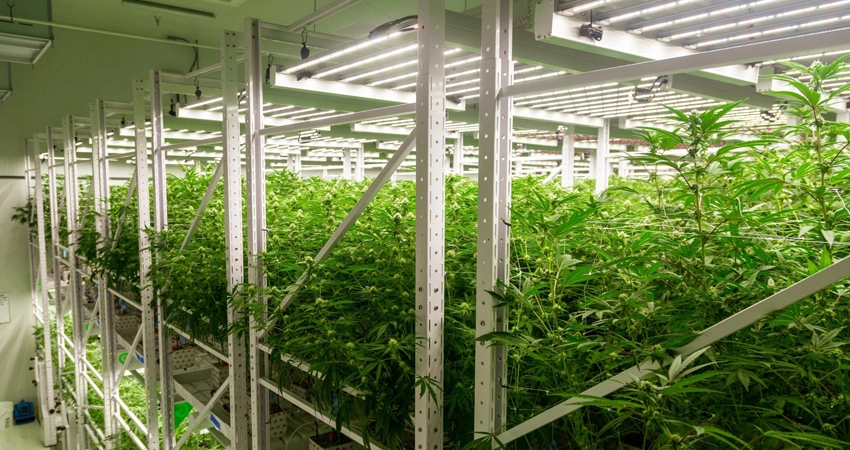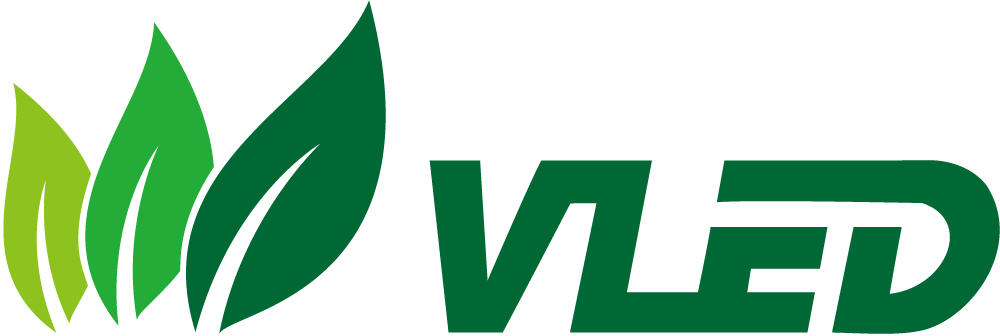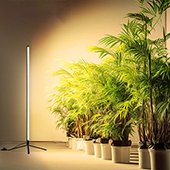Menu
Understanding LED Grow Lights for Growing Cannabis
With the legalization of cannabis cultivation in some countries in Europe, America, and Southeast Asia, and the increasing maturity of LED grow light technology over the past five years, it has become more prevalent in plant cultivation, opening up vast market opportunities. Below is a brief analysis of the use of LED grow lights in cannabis cultivation.
Table of Contents
LED Grow Lights vs Traditional Plant Lights
There are mainly three types of indoor plant growth lights: High-Intensity Discharge (HID) lamps, fluorescent lamps, and LED lights. Each type of light has its advantages and disadvantages, but they can be used for indoor cannabis cultivation. I will focus on LED grow lights.
The main selling point of LED lights is that they produce powerful spectra without generating a large amount of heat. Depending on the LED grow lights purchased and used by users, there may be no need to invest in a fan exhaust system (typically recommended when growing in enclosed environments to ensure sufficient airflow for plants).
Another advantage of LED grow lights is their simple setup. Typically, all users need to do is plug these lights into a power outlet, hang them above the plants, and then turn on the device.
One thing to consider is how much energy cost savings LED cannabis grow lights will provide. The amount of energy used by HID lights can result in a significant increase in users’ electricity bills. This not only costs a lot of money but also attracts unnecessary attention from landlords, neighbors, and law enforcement.
When people have to keep their cannabis cultivation activities secret, the skyrocketing electricity bills often lead them to abandon them.
Although cannabis is legal in many areas now, it doesn’t necessarily mean that users want the entire community to know what they’re doing.
Reducing water usage. LED plant lights not only are more energy-efficient but also can save water.
Since HID lights consume a significant amount of energy, resulting in more heat production, this significantly increases the temperature in the grow room, leading to plants consuming more water.
Cannabis requires a large amount of water compared to other plants, and even growing a small number of plants can consume a significant amount of water.
Any method to reduce water usage is beneficial to the environment, not to mention the benefits to users’ water and electricity bills.
LED grow lights have a longer lifespan compared to HID or CFL bulbs, ensuring they can be used effectively for many years before needing replacement.
Traditional cannabis grow lights typically last for around 20,000 hours. In contrast, LED bulbs have a lifespan of more than double this, reaching up to 50,000 hours, and sometimes even 100,000 hours (though this should be distinguished from light degradation).
Cost is not the only reason for users to switch to LED lights. Experienced growers know that seedlings and plants in the vegetative stage benefit more from blue light while flowering plants require red light to thrive.
Before the advent of LEDs, growers had to purchase two different types of lights: metal halide lamps for plant growth or blue-rich lighting, and high-pressure sodium lamps for the final flowering stage.
With LED cannabis grow lights, this is no longer the case. LEDs with different wavelengths allow growers to manipulate the spectrum, enabling users to use the same lighting setup for both growth stages. This not only eliminates the need to purchase two different types of lighting setups but also ensures that users’ plants receive optimal results!
With LED cannabis grow lights, the situation is different. LEDs with different light wavelengths allow growers to manipulate the spectrum, enabling users to use the same lighting setup for both growth stages. This not only eliminates the need to purchase two different types of lighting setups but also ensures that users’ plants achieve optimal results!
If users want to cultivate multiple plants, they don’t need to purchase more expensive HID lights. They can simply add several larger LED lights or several smaller LED bulbs to the greenhouse.
If users choose the latter option, they need to ensure that there is a reasonable distance between the plants and the lights because users want to ensure that each plant receives sufficient light. Using too few lights can cause stretching while using too many lights can risk light burn on plants and excessive energy consumption.
With cutting-edge technology, LED grow lights have a significant advantage in meeting the lighting needs of cannabis plants. This lighting system is also popular overseas because it generates minimal heat and doesn’t require cooling systems to maintain safe and reliable light fixture temperatures.
Spectrum and Its Effects in Plant Lighting
Where Does the Spectrum Come into Play?
In simple terms, it’s all the different colors visible under sunlight. If we were to look at the spectrum, it would resemble a rainbow.
The wavelengths of light that we humans see fall between 380 and 700 nm, while plants’ sensitivity to light ranges from 300 to 800 nm.
What we call “blue light” has wavelengths between 420 and 460 nm. They may look the same to us, but they have different properties.
All colors are necessary, but some colors are much more important than others. Cannabis plants respond well to blue and yellow/red light. Blue light is located at the lower end of the spectrum, what we commonly refer to as “cool colors” in everyday life, while yellow/red light appears warmer to our eyes.
Let’s step outside and observe the sunlight spectrum throughout the year.
During summer, due to the sun being high and the sky very bright, blue light is most prominent. Cannabis plants will become stronger when using grow lights with a higher proportion of blue light. The blue light spectrum ranges from 400-500 nm, with an ideal value around 460 nm.
During the flowering stage, red light will promote higher yields. Later in the year, you can see warmer light as the sun descends lower in the sky with reduced brightness.
Cannabis plants recognize this as a sign to begin flowering, so grow lights with a higher quantity of red light components are most suitable for the flowering stage. The red spectrum ranges from 620 to 780 nm, with an ideal value around 660 nm.
In summary, using an accurate spectrum alone cannot determine the success or failure of crops. Most plant lights available on the market today include sufficient blue and red light, ensuring plants have no issues from seedling to harvest.
If you prefer plants to grow taller with more space between nodes, you can use warmer grow lights during the plant growth stage. Recent studies suggest that red light is more beneficial to plants because blue light drives photosynthesis with lower efficiency.

Intensity, Refers to the Power of the Light Source
In more technical terms, it’s the amount of light energy per unit area. Different plant grow lights will have varying intensities because factors such as the height at which the light is hung, and the type, and quality of the light source affect intensity.
Light intensity peaks at the light source itself and then diminishes as distance increases. Therefore, plants directly under a grow light receive much stronger light intensity than those several feet away. All plants need light to thrive—that’s the whole reason for needing plant grow lights!
However, light intensity can both enhance and hinder plant growth.
For instance, we place all plants very close to the grow light to maximize intensity. Sounds good, right? But prolonged exposure to strong light can scorch and burn plants, leaving their leaves dry and withered. This occurs because plants absorb too much energy, leading to self-destruction.
On the other hand, if light is too scarce, plants won’t be able to produce chlorophyll. Worse yet, they’ll start elongating towards the light source in a phenomenon known as etiolation. They’re essentially reaching out for more light.
Having the right light intensity is crucial to ensuring successful crop growth. The best plant grow lights will provide optimal light intensity for plants and will also provide detailed information regarding their coverage area and recommended hanging height in the facility.
Photosynthetically Active Radiation (PAR)
PAR stands for Photosynthetically Active Radiation. Essentially, these are the wavelengths of light that plants use in photosynthesis. This is crucial for the proper and effective cultivation of cannabis.
It is typically measured in watts per square meter (W/m²) to determine how much PAR reaches the entire canopy. However, the energy contained within photons in the chemical reactions of photosynthesis depends more on the quantity of photons.
Plant biologists often quantify PAR by the number of photons received within a specified period, known as Photosynthetic Photon Flux Density (PPFD), within the range of 400-700 nm.
Photosynthetic Photon Flux Density (PPFD)
The Photosynthetic Photon Flux Density (PPFD) tells us about the intensity of light. PPFD is measured in micromoles per square meter per second: μmol · m-2 · s -1. This describes the number of active photons that hit the surface of a one-square-meter area in one second.
In a 2010 study regarding the PPFD values required for cannabis, it was found that a value between 1500 and 2000 is optimal for indoor cannabis cultivation.
Determining the Number of LED Grow Lights Needed
What Size LED Grow Light Do I Need?
A good rule of thumb is to select LED grow lights that output at least 50 watts per square foot of growing space to achieve optimal yield. This can serve as an important reference point.
In a growing greenhouse, lights are a crucial component. Light is essentially food for plants, and you need to provide high-quality food to ensure they produce high-quality yields.
Due to their energy efficiency, durability, and full spectrum, LED grow lights are now considered by most growers to be the best lighting option.
However, even with knowledge of selecting LED grow lights and related technical terms, finding the right grow light for your cultivation project can still be a bit overwhelming. To determine the size of LED grow lights needed, you first need to calculate the exact dimensions of your growing space.
The Size of the Growing Space
When growing cannabis, a good rule of thumb is to use at least 50 watts of LED grow lights per square foot of growing space.
We want to feed our plants with light so that they have enough energy to produce strong buds. And we need to calculate the square footage of the growing space (length x width). Then we multiply this number by 50 watts to get the approximate wattage of grow lights we need.
For example, if I have a growing space that is 2 ft long and 3 ft wide. This gives me 6 square feet of growing space, and then I would multiply this number by 50 watts to get 300 watts. In this example, I would need an LED grow light of at least 300 watts.

How Many Plants Can be Grown?
Generally, each cannabis plant requires at least 1 square foot of growing space.
After germination, many growers prefer to place one plant in a large 5-gallon planting bag with a diameter of about 1 square foot, and the cannabis plant will remain in this pot until it flowers.
This allows the plant to grow large and strong without being hindered by other plants or the tent’s surroundings. This avoids the need for frequent transplanting, which can stress the plants significantly.
For detailed guidelines, please click and read this post(How Many Plants Per LED Grow Light?).
Ensure Your Canopy is Covered
It’s important to understand that most LED plant grow lights typically cover only about 1-6 plants.
If you have plans to grow more, you’ll need to purchase multiple lights hung side by side to ensure each plant receives the same amount of light.
The table below outlines how the wattage you need increases with the size of your growing space, and it also includes how many plants each size of grow light is suitable for.
Note: 1 square foot of growing space = 50 watts of LED plant grow light
In these scenarios, the size of the growing space will require you to purchase multiple lights hung side by side to ensure the entire canopy receives light.
Growing Space | Power of Grow Light | Number of plants |
2 sq ft (2 x 1) | 100W | 1-2 plants |
4 sq ft (2 x 2) | 200W | 1-3 plants |
6 sq ft (2 x 3) | 300W | 1-6 plants |
9 sq ft (3 x 3) | 450W | 1-9 plants |
12 sq ft (3 x 4) | 600W | 1-12 plants |
16 sq ft (4 x 4) | 800W | 1-16 plants |
20 sq ft (4 x 5) | 1000W | 1-20 plants |
Note: The values above are for reference during the flowering stage. During the seedling and vegetative stages, you may need to lower the wattage as needed.
Understanding PAR Output
PAR, is part of the spectrum parameters that measure the light used by plants for photosynthesis. The higher the PAR output of a plant light, the more light the plants receive.
The table below outlines the ideal PAR ranges for each stage of the cannabis growth cycle:
Ideally, you would want to select LED plant lights that output PAR within the ranges mentioned above. This almost rules out LED grow lights below 300 watts, as they simply don’t have enough power to produce the required PAR levels.
These are the optimal levels for PAR, and using grow lights with PAR outputs below these ranges won’t have any serious detrimental effects, but it won’t maximize the potential for plant growth.
Growth Stage | Optimal PAR for Output |
Seedling | 200-400 (umol/m2/s) |
Veg | 600-600 (umol/m2/s) |
Flowering | 600-900 (umol/m2/s) |
Cost of Lighting Usage
Taking a 1000 square feet growing space as an example:
Based on the illumination requirements during the flowering period, we need 50W lights per square foot.
For 1000 square feet, the total wattage needed would be 50W × 1000 = 50,000W = 50KW.
Calculating based on 16 hours of lighting per day, the daily electricity consumption for lighting would be 50KW × 16 = 800KWH.
Get in touch with us!
From custom light planning, to tailored quotes, and everything in between, our team of horticulture experts are always ready to assist.




